#sophonts
Text


KNIGHT DEITIES
It's been a hot minute since I posted Vivere 44 art. Been intensely busy with school for the past few months but now that I've graduated I've got a lot of time to kill! Since the Knights post surpassed 1k notes I figured I may as well elaborate on them more. I'm so blown away by how much love they're getting already! Thank you all <3
I'm gonna talk a bit about Mountain and Plains Knight religions, mythology and a snippet of evolutionary history. I will cover Polar Knight religions in another post. The focus is on two gods in particular, Uwet-Jana and Kiraiarik.
_______
Uwet-Jana is the demigod of good health, vitality, and inner balance. In some regions they are also the god of fertility. The name of their Host is Uwetsil, and their Helmet is Serrjana. Mainly worshiped by Mountain cultures, Uwet-Jana takes the form of a Knight whose Host and Helmet are physically merged into a singular being.
Kiraiarik [pronounced ki-rai-ah-rik] is the personification of the host-helmet symbiotic relationship. They are the god of symbiosis, rebirth, and love. Kiraiarik was the name given to two immortal partners, a Host and a Helmet, who began as a singular being born to the sea in Ettera’s prehistoric era. Ettera decided to make them Two, one half (the Helmet) ruling over the sea and the other (the Host) having domain over the land. The story goes that in every form they take, they try to find each other - for their body remembers being One.
Both gods have lots of lore to their name. Further information below!
UWET-JANA
Uwet-Jana's Host body has long spines and red stripes like a Pike, and long fingerlike paws like a Helmet's manipulators. The Helmet section sports two long horns and elegant facial markings. Uwet-Jana has an iridescent sheen on their golden fur, catching the rays of the sun in a shimmering glow.
The story of Uwet-Jana is as follows: Both Uwetsil and Serrjana were born as runts, in a dark time when sickly Knights were seen as curses and not worth caring for. Their Order, believing them to be bad omens, cast them out to wander the tundra alone. They believed that the natural forces of Ettera (the Knight’s homeplanet) would quickly end them. However, Ettera took pity on the castaway, sending them three blessings. The first gift was a bone with marrow inside that ensured one is never hungry or thirsty again. Then, Ettera sent a warm, sweet wind into Uwet-Jana’s lungs which warded off all sickness and disease. Finally, a sun shower fell, the rains cleansing them and blessing them with a coat made of ivory and gold.
Transformed into a demigod with a hybrid body, Uwet-Jana was offered a place among the deities in the sky - but they refused, preferring to stay on the ground to share their gift with the mortals. Unbeknownst to them, their Order who had exiled them was struck by three curses from the Gods to mirror Uwet-Jana’s blessings: all the rivers in the area dried up and all their hunts were unsuccessful, leaving them with no food or water. Infections and diseases picked them off one by one, and a great storm ravaged the land, destroying their home and all remaining survivors. Uwet-Jana now blesses Knight Orders who take care of their sick and ailing members, and ignores those who don’t, leaving them to the wrath of the Gods.
Although they are nomadic and always on the move, many Mountain Orders will refuse to leave any sick members behind. They may also keep ivory statues of Uwet-Jana in their bags as a token of good fortune. Sometimes these statues are filled with bone marrow, or have holes which make a whistling sound as wind passes through it as a reference to Ettera’s gifts. Occasionally Pike Helmets are born with an extra long ‘horn’ spike, and are considered a child/reincarnation of Uwet-Jana. Additionally, whenever it rains while the sun is still shining, it is seen as a blessing from the demigod.
_______
KIRAIARIK
Kiraiarik's Host is depicted as a small creature with a striped pelt to mirror its ancestral form, and the Helmet as an aquatic beast with long, trailing red fins. It is frequently shown twisting around the Host, sharing its blood. Kiraiarik is also often simplified as two disembodied eyes looking at each other. (And yes, the artstyle is a nod to medieval depictions of heraldic beasts!)
To understand Kiraiarik, one must be aware of how much Plains religions are intrinsically tied to concepts of evolution and paleontology.
Digression on the origins of Etteran symbiosis:
Large stretches of Plains Knight deserts and scrublands were once submerged beneath the sea. As a result, there are countless fossil hotspots which have been unearthed over the centuries. These high concentrations of fossilised remains have lead to Plains cultures basing their religions around said discoveries. Although many features have been warped, the general timelines are strikingly similar.
For instance, a mass extinction event occurred on Ettera millions of years ago, caused by a series of catastrophic volcanic eruptions on a worldwide scale. This event is known in Plains culture as The Remaking, traditionally interpreted as the planet shedding its skin. Many species were decimated, but some groups survived; these happened to be phyla who possessed an exposed ‘Interfacer’ organ, a precursor to the specialised Integrator organ which connects the Host’s brain to the Helmet’s. Before The Remaking, there was no prior record of the deep symbiotic connection which Knights possess (scientifically deemed ‘Hyperadvanced Mutualism’). The Interfacer organ was used in the phyla for species to communicate simple stretches of data to each other, such as health and reproductive status. After the extinction, populations of these species were dwindling. To ensure their survival, an odd phenomenon occurred in which many individuals began to interface with different species who possessed the same organ - strangely enough, some were able to successfully exchange information. These individuals survived and passed on the practice to their offspring, eventually culminating in what would be discovered as a very primitive form of mutualism. Host and Helmet ancestors (pictured above) were some of the first species to achieve this.
As the planet recovered and populations increased, the relationship continued to solidify and become more complex, with symbiotic species sharing memories, emotions and complex thought. In modern times there is now an entire class of organisms on Ettera which possess an Integrator organ for Advanced Mutualism, including Knights.
Kiraiarik is said to be a manifestation of this relationship. After The Remaking, their two halves finally managed to find each other again, eternally locked in a joyous dance of love. (Side note: the love in question is not platonic nor romantic, but a deeper kind which is indescribable and not easily understood. Due to their intricate nervous systems, Knights have a higher degree of emotional intelligence and can experience sensations we would consider alien). When a Plains Knight is experiencing inner turmoil, they will often pray to Kiraiarik to restore a healthy connection. The god’s blessing is also called upon when an infant Host and Helmet first Assimilate.
Note: Many Plains ‘saints’ and deities have palindromic names which can be read both forwards and backwards, an indicator of holiness. Fun fact, the word Kiraiariku means “Your heart and mine are very old friends.”
Thank you for reading! More Knight content coming soon ;)
#come get yo foood#vivere 44#my art#knights#speculative biology#spec bio#speculative evolution#sophonts#spec evo#xenobiology#art#illustration#worldbuilding#artists on tumblr#good god I have been working on this for over a month.#also been playing around with a fun new brush#a bit painterly and experimental
1K notes
·
View notes
Text
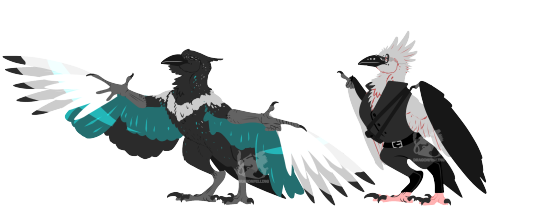


Official Ascendancy Sophonts post (2)
Iris, Half-Nidus, Nidus
PLEASE, do not use for your own DND stuff or as ocs without asking me first.
155 notes
·
View notes
Text
Reyal At A Glance - Climate

Map by @nexelart (twit)
Reyal - A World of Extremes
As per the previous post stated, Reyal is much like our own Earth in terms of biodiversity, as well as a few other traits. In this post, we'll explore Reyal's weather and biosphere a bit more!
Reyal's climate has shifted greatly during it's history. From the early start of life, it was a much hotter world; it's atmosphere used to contain much higher amounts of carbon dioxide and other greenhouse gasses, making it a much more tropical world than it is today.
Nowadays, Reyal experiences a much colder climate than Earth, as it lost much of it's greenhouse gasses during its several billion year long evolution. On top of this, Reyal orbits a bit further out from Tenav's habitable zone than we do around our own Sol.
At the poles, including wind chill, temperatures drop down to -103c on average at the surface. At the equator, the highest you can expect is a balmy 27c. Weather can of course influence these temperatures, but thanks to Reyal's lack of seasons and relative climatic stability, these tend to be year-round temperatures.
Thanks to it's colder climate, most of the planet is dominated by humid continental biomes, as well taiga and tundra. Due to a lack of water compared to Earth, most of the equator tends to be dominated by savanna and desert, with only a few key areas near the equator bearing rainforests.
Life has taken a massive advantage of this stability, and as such, Reyal can be very well described as a garden planet. Flowers and fruiting plants tend to grow very rapidly, leading to an abundance of food and other biological resources.
This all works out perfectly for the Lyratet, however, as they have evolved to be more adapted to colder climates. Due to their thick fur, habitation near or on the equator is near impossible, lest they suffer from the effects of overheating. Only a few settlements exist in the equator, and are primarily underground. Despite the heat, some do inhabit the surface briefly during the night or Tenavset/rise.

Edit of @nexelart's map, showing the equator and northernmost/southernmost parts of the poles greyed out
As seen in the image above, this excludes a fairly large part of Reyal for habitation. Most of the equator is designated as a ecological reserve then, with very little being known about it. Scientists do mount expeditions to document flora and fauna, but more often than not, the region is left to itself.
This lack of habitability at the equator has greatly affected Lyratet history. For almost the entirety of the two hundred thousand years that they have first had cultures, they had no real means of accessing the northern hemisphere. As such, they were relegated to the south, and struggled to develop for much of their history.
In what would be 1113 A.D. our calendar, two brave souls finally took it upon themselves to transfer through the mountain ranges that intersect with the Great Desert Rings, and set foot up north. This is a story for another time, though!
In the next post, we'll be exploring the origin land of the Lyratet; the Land of Tenav's Dawn.
Directory: Intro | Climate | the Land of Tenav's Dawn | the Desert Rings | Therikine | the Great Central Desert Mountains | the North Glacial Plains | the Yuniv-Semat Basin | Juleg Marrdev Technocracy | Yuniv-Semat Trail | Ro | Velgae
#my posts#reyal#reyal at a glance#worldbuilding#creative writing#writeblr#speculative evolution#spec evo#sophonts#aliens#as we go along#awga
30 notes
·
View notes
Text
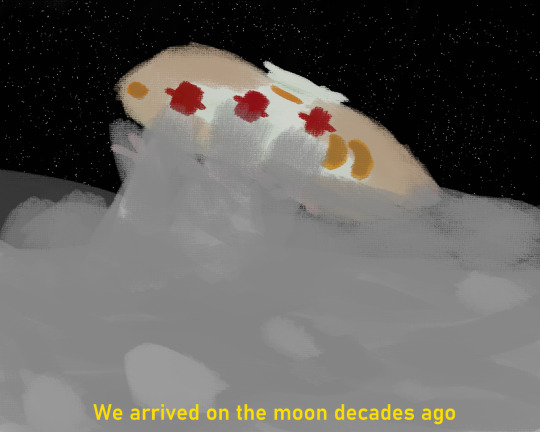
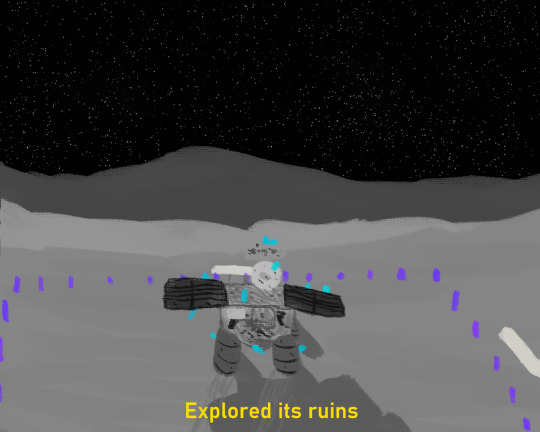


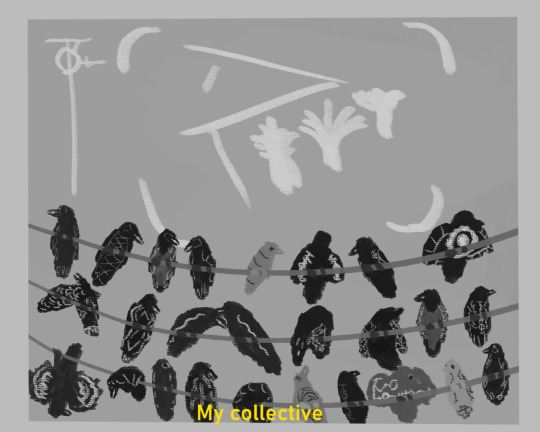


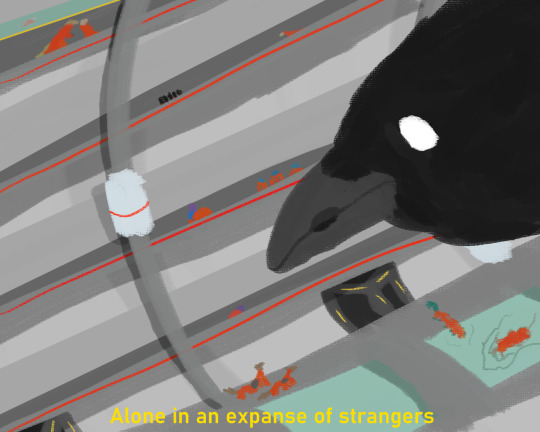

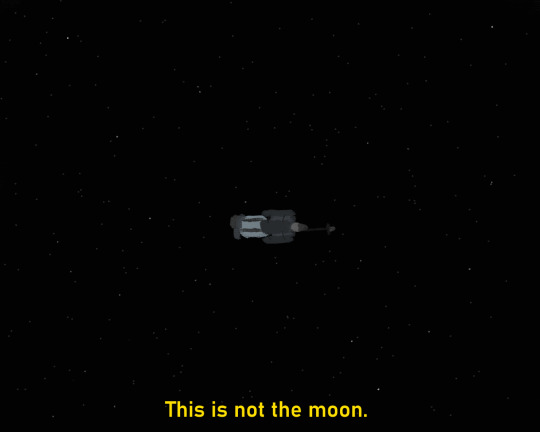
This is not the moon.
Little thing for the Space Station AU on @styllwaters Discord server, plenty of people's sophonts in an uh...odd situation. Try and spot them all on panel 8
#art#digital art#corvid#crow#digital painting#raven#director#This Grand Nest#sophonts#spec bio#spec evo#speculative evolution#speculative biology#comic#Space station au#seacrawler#kyhuine#maanul#geoling#Scelids#uniima#chirper#spearhead#heneran#space#moon#post apocalyptic#Yutu 2#lunar plaque#(Those are just a paper copy and a replica don't worry)
104 notes
·
View notes
Photo
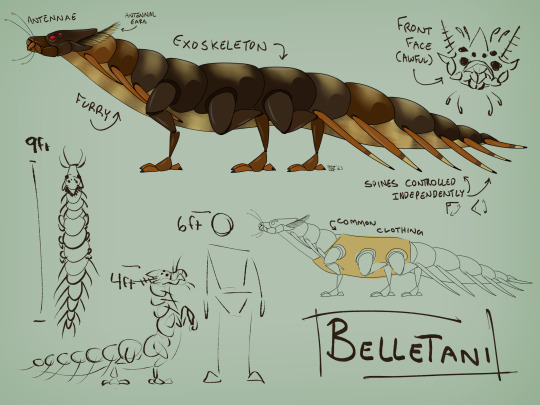
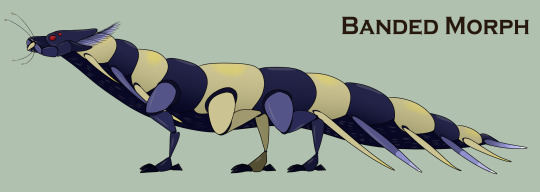

another sophont let’s go The Belletani of the planets Belletane and Sibellati, and their respective moons (Ia & Ettal; Besa)
Belletani are the leading creators of space vessels and are constantly working to make improvements. their pursuit of technology has had detrimental effects on their home planet Belletane, but recent work from local conservationists has helped to preserve what is left.
they come in lots of different colours, but these three (brown, banded, and silver) are the most widespread ancestral morphs seen, and lots of variants use one of them as a base. having offspring is no longer fully a biological process for them, rather a scientific one, and morphs are usually chosen and made for aesthetics.
Belletani do not traditionally wear clothing, unless it is protective, but some choose to wear it in mixed company for the comfort of others.
#spec bio#speculative biology#speculative evolution#speculative zoology#speculative fiction#creature design#sophonts#xenobiology#aliens#alien design#my art#theyre descended from centipede-like creatures but have turned all but 6 legs into spines#the belletani have been in design-limbo for years lmao#im finally happy after increasing their insecty-ness#they were originally much more lizard-like#pls enjoy this i hate bugs and i had to look at so many of their faces
70 notes
·
View notes
Text
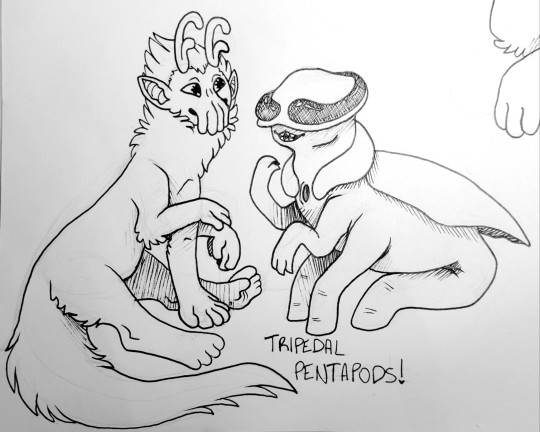
Had to draw @extrajigs Whorls with my species, the Lirri as soon as I saw them. They're tripedal pentapod friends!
#mine#also not mine?#my art including others species#spec bio#spec evo#sophonts#lirri#whorls#extrajigs#tripedal pentapods#pentapods#tripeds#speculative aliens#xenobiology
12 notes
·
View notes
Text
Remotusverse sophonts
Long post under cut
Feel free to send asks and questions :)

From left to right:
Laagharee (Kenterians)
Carnivorous bird species originating from now uninhabitable planet.
Average adult height is 250cm, weight - 170kg. Males are a bit taller, have vibrant colored eyes and dark feathers. Females are bulkier and shorter, have vider shoulders and hips and generally physically stronger than males. They have light colored feathers and dull eyes.
Male and female coloration from different ethnicities:

Kenterians lay large softshell eggs (1-2 at a time). Hatchlings are the size of an adult cat. Unlike adults children are almost fully feathered and loose their feathers when they reach adulthood at 25-35 years old. Laagharee live up to 200 years or more.
Laagharee child:

Kenterians have a very complex voicebox, that allows them to make and mimic a wide variety of sounds. Their language is very complex and often uses whistles, hissed, clicks and other sounds besides regular phonemes. This makes understanding and speaking hard for other aliens, so there is a more widely used simplified version of the language. Writing system has letters and symbols for sounds(most sounds are not used in simplified version) and also vowel length indicators (and tone indicators in complex version).
Garavi

Definitely not your typical human placeholder species ;)
Look like humans, live like humans, function like humans.
Except they have horns, copper based blood, blue meat and different skin pigmentation.
Garavi can be blue, teal, lime and yellow colored. Basically blue=white, green=brown and yellow=dark skin (and corresponding ethnicities idk how to phrase it) . Pigment is tied to genetics and not sun exposure but is kinda influenced by it. Also they can't tan.
Horns are about 3-5cm long and can have different shapes. Females horns are a bit smaller than males. Horns are solely for display purposes and in modern times don't have any practical uses.
Tagaar
Humanoid obligate carnivore. Apex predator of their harsh cold homeplanet.
On the outside they look similar to garavi but are actually very different. The most obvious features are 12 red facet eyes, head crest and 6 tendrils. Their skin color and patterns varies from blues to browns with stripes and spots.
Crest and tendrils are used in display and termoregulation . Males crest and tendrils are bigger and pointier, females have smaller and smoother crest and round tendrils.
Inside the tendrils there are secretary glands that produce antifreeze liquid that absorbs and keeps warmth. This liquid spreads under the skin across all body, and keeps tagaar from freezing. Tagaar people have a unique termoregulation system. When outside temperature is warm their body only absorbs the heat, in cold temperatures antifreeze liquid keeps heat inside the body and only after a few hours when it cools down the body starts to produce its own heat. Unfortunately if very how weather (over 25-30°C) this can lead to overheating, fainting and even death.
Out of their 12 eyes only bigger two see color. Other eyes are pointed to the sides and detect movement and heat instead. Tagaar have a worse color vision and do not see green.
Tagaar also have sharp teeth, wide opening outer jaw and flexible inside jaw, hidden inside the throat and powerful jaw muscles. Their salvia contains ferments that prevent blood clotting and promotes wound rot.

Females lay 8 - 10 round semi transparent fist sized eggs. After two months larva hatches. Larvae are small and white, they have exposed inner jaw and developing outer jaw, their bones are soft, limbs are extremely short, and they also have a tail to store nutrients. After 3-4 years larva forms a cocoon out of its tail and will morph into a imago for another two years. After morphing tagaar resembles adults, grows out limbs, proper jaw, small crest and tendrils, forms a sex and continues development into an adult.
Cana-omi
Small, four armed hermaphrodite obligate herbivores.
Species name translates to "pinecone head". Two growths on their head and two pairs of arms are their most prominent features.
Their hands have four digits, two of tnem being thumbs. Feet have similar structure. This alows them to easily climb gigantic trees of their home planet.
Their skin is covered in thin fur and it's color can change from brown to green depending on the persons mood, wellbeing and hormonal cycle.
Cones on their head contain some sensory organs and hormone secreting glands. Under the first skin fold there are ears. There are nostrills in between theic cheeks and cones and another pair on their chest.
Cana-omi are hermaphrodites and chage sex in yearly cycles. I haven't thought more about their reproductive system for now.
Tcha'chsi
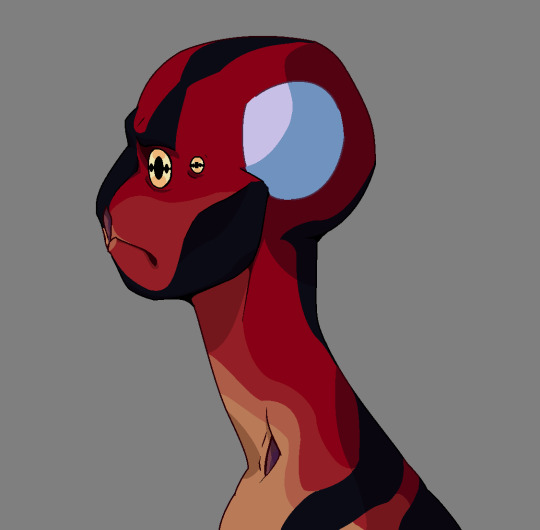
Small flying sophonts. Their species is currently uncontacted (except only one individual) and is in it's medieval age.
They have bat like wings with membranes stretched from tail to fingers and are capable of active flight. They use their feet as hands instead.
They have tastebuds on their face that can smell and taste things. Inside their mouth are 4 venomous fangs. Tcha'chsi poison their prey and swallow it whole.
They speak in clicks and scritches from two nostrills on the base of their necks.
Tcha'chsi have 5 sexes, two "female" , three "male". Females are white and gray, and males are yellow, orange and red. Red colred males are considered a lower caste of society and are forbidden from reproducing.
Shiarha

They are a species of four armed cannivorous lizards. Currently uncontacted but space developed.
They can lift frills on their head to intimidate oponents. Males have bigger red frills and bright red throat used in mating displays.
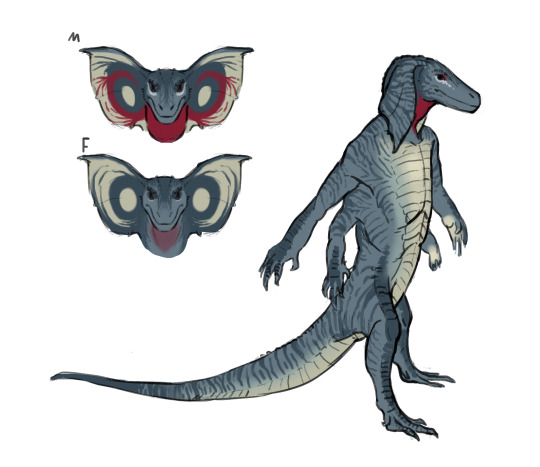
Communicate mainly in hisses and short words and tail gestures.
(You probably won't see many content on them sorry not sorry)
Other sophonts
- questionably sentient sea slugs
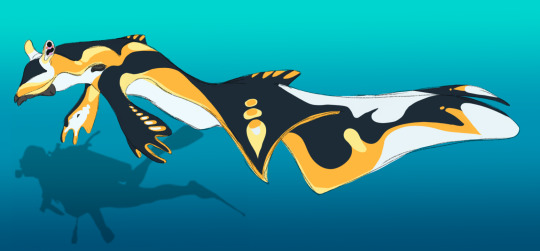
- extinct octopus-like guys
- silicon based whatever is it
-triangles

- Giant planet eating but surprisingly gentle monster.
- other paranormal creatures
#Remotusverse#my art#original species#speculative biology#Space#Sci fi#Sophonts#Laagharee#Kenterians#Garavi#Tagaar#Tcha'chsi#Shiarha
25 notes
·
View notes
Text
I never stop talking about how I believe if there was an elemental system of sophont species in the universe, humans would be "poison" type, at the very least because we cultivate micro-organisms in our mouth-hole that make our spit and snot and bites deadly to any other species and sometimes even other humans
And, like. Can you picture it.
It is one thing if a "poison" type is like a colourful striped snake thing or a neon green space bug.
But picture like a middle aged white salaryman with the label "poison" type. "This thing is gonna bite you and that will kill you". Absolutely glorious and wretched.
10 notes
·
View notes
Text
Sophont Species Masterlist
Tieflings
Alites (bird-folk)
Merfolk
Elves
Lacerta (reptile-folk)
Pelligeri (mammal-folk)
Rei Parva (fairylike-folk)
Hasharatins (insect-folk)
#original#sophonts#tieflings#alites#merfolk#elves#lacertans#pelligeri#rei parva#hasharatins#masterlist#list#links
0 notes
Text
NEW ALIEN

I call them Ocira. They're a sort of combination of seals and octopus. They're eusocial and very kind
That wrinkly thing on their chest are their gills, which they can use to express certain emotions.
Their "teeth" are truly spines that can be raised to eat meat, or flattened to chomp plants.
To communicate, they do a sort of drumming and pinching of their swim bladders for different tones and squeaks.
They live on an ocean planet, in shallow, warm waters around reefs.
I might draw them more and tell more about them 😸
#art#digital art#orcatnip#xenobiology#spec bio#speculative biology#alien oc#meow#original creature#creature design#sophont
2K notes
·
View notes
Text
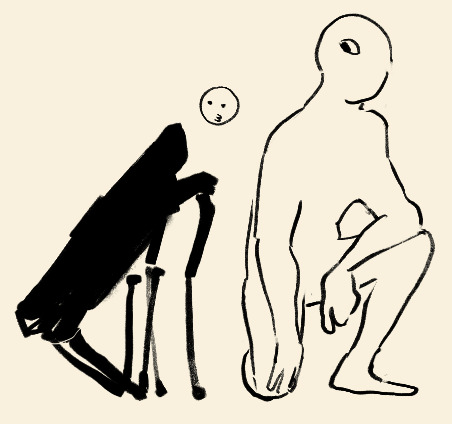

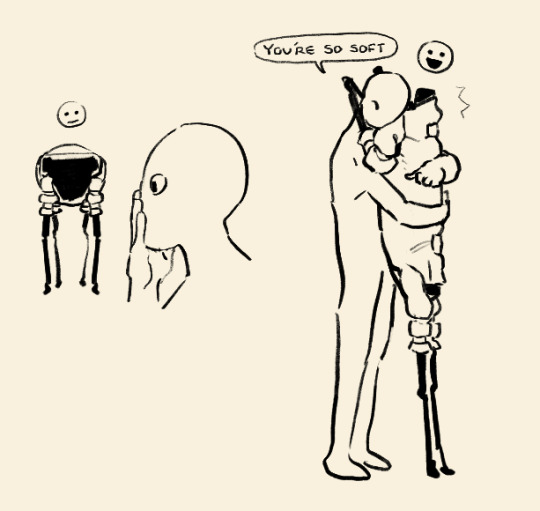




Pinch protection jacket and being loved in your default state.
2K notes
·
View notes
Note
Baby Knight??

I'll do you one better - baby knights!
#plains#they're looking at a cool bug they found#these guys are still very young so the plains and mountain have darker hosts and helmets#polar gagas start out with lighter coloured helmets#spec bio#doodle requests#vivere 44#my art#art#knights#sophonts#illustration#speculative biology#spec evo#aliens
306 notes
·
View notes
Text

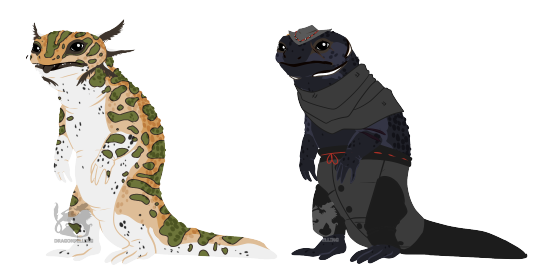
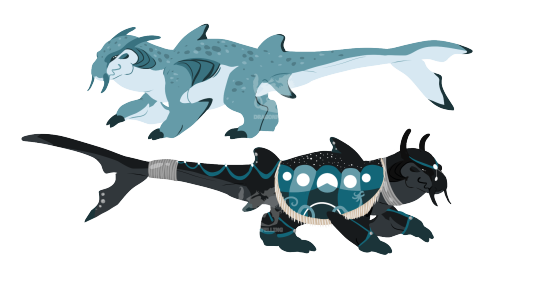
Official Ascendancy Sophonts post (3)
Eute and I Peshka
PLEASE, do not use for your own DND stuff or as ocs without asking me first.
#ascendancy#art#digital art#eute#ipeshka#i peshka#peshka#salamander#axolotl#shark#fish#dnd#types of guys#sophonts
35 notes
·
View notes
Text
Reyal At A Glance - Intro
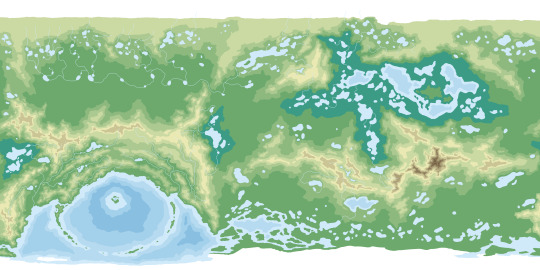
Map by @nexelart (twit)
Welcome to Reyal, the second planet from Tenav!
Reyal is a planet much like our own Earth, in that it supports a wide array of life and boasts a large hydrosphere. On top of that, it's only 1.27x larger than Earth, and has an atmospheric composition fairly similar to our own, with Reyal having 26.71% oxygen content as compared to Earth's 20.95%.
There, however, is where the similarities end.
Reyal has an orbital period of only 3.27 months, as Tenav is only a K7V class star. As such, Reyal doesn't really experience any seasons as we do here on Earth. Any changes are barely noticeable as it speeds around Tenav, causing only minor temperature differences during their year.
On top of that, Reyal experiences much heavier tidal activity, as it has two decently sized moons, Ro and Velgae. In conjunction with Tenav, volcanism and ocean/lake tides tend to be a bit more on the extreme side of things when compared to Earth.
Life emerged on Reyal some 4.7bn years ago, only a few hundred million years after the formation of Ro. Life on Reyal has never had it easy; from asteroids, comets, heavy glacial and hothouse periods, life on Reyal has seen the edge of oblivion numerous time.
Despite all this, life has found a way, and has thrived and even flourished through the ages. No example is better than Reyal's own sapient race, the Lyratet.
In this series of posts, I will be covering some key areas on Reyal, and going over their history and importance to the Lyratet; I hope you enjoy!
Directory: Intro | Climate | the Land of Tenav's Dawn | the Desert Rings | Therikine | the Great Central Desert Mountains | the North Glacial Plains | the Yuniv-Semat Basin | Juleg Marrdev Technocracy | Yuniv-Semat Trail | Ro | Velgae
#my posts#maps#Reyal#worldbuilding#reyal at a glance#creative writing#sophonts#aliens#writeblr#as we go along#awga
23 notes
·
View notes
Text

handses and feetses redesign
without text
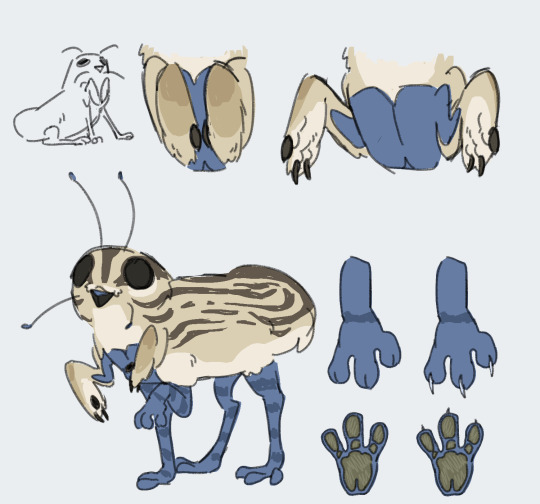
#ensthir#spec bio#spec evo#speculative biology#speculative evolution#speculative zoology#original species#alien species#sophont
1K notes
·
View notes
Photo

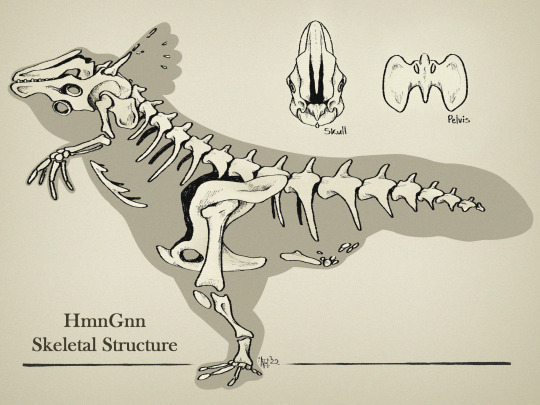

I’ve got a handful of alien sophont species in the works, but these guys are somehow the ones with the most finished art! Meet the HmnGnn’s
Their planet - Nee Segleea - is mostly water, but has some islands and island chains. They live the majority of life on land, but rely on the sea for food and return to it for breeding.
They have a more advanced planetary neighbour who initiated contact with them, bringing them both into the community of the United Alliance of Peoples (UAP). The largest island and city now houses Nee Segleea’s singular spaceport.
HmnGnn’s technically have 4 pairs of limbs: legs, arms, breeding limbs, and flags/fins. The flags are used for communicating emotion and danger signals, as well as pale displays. The patterns are unique to the individual and are hereditary.
Each set of eyes are also highly specialized: bottom are binocular and see underwater; top are monocular and are used for sight above water; and the eye stalks really only see movement and high contrast, while in water they are used to keep watch above the surface, whether for predators or warnings from other HmnGnn’s.
Shade:
Largest body size (5-6ft tall)
Darkest colours
Brooder arms
Produces 1-3 eggs that are fertilized internally
Forms an egg sac that is held by the brooder arms until hatching
Pale:
Medium body size (4.5-5.5ft tall)
Lighter in colour than Shades
Claspers
Produces sperm
Largest and most vibrant flags
Flags and tail become colourful in the mating season
Stripe:
Smallest body size (3.5-4ft tall)
Called such for the stripe each one has on eir tail
Vestigial claspers
Does not have sexual organs
Raises the young
- produces a nutritious liquid for the young during regurgitation
Largest tail
- young grip onto it on land and in water
#speculative biology#speculative evolution#xenobiology#spec bio#creature design#HmnGnns#sci fi#spec evo#speculative zoology#sophonts#original species#my art#CoS#nee segleea
79 notes
·
View notes